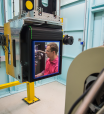ANSTO’s virtual and augmented reality experience
An opportunity to take an unforgettable journey and explore ANSTO science virtually at the atomic scale for National #scienceweek

Showing 81 - 100 of 179 results
An opportunity to take an unforgettable journey and explore ANSTO science virtually at the atomic scale for National #scienceweek

ANSTO researchers contribute to study which finds evidence of Aboriginal occupation 65,000 years ago in Northern Australia.
Research highlights how biodistribution of a toxic substance essential to understand all exposure risks.

Andrew Peele was appointed Group Executive for ANSTO Nuclear Science and Technology in July 2021 and was Director of the Australian Synchrotron from 2013 -2021. He is an adjunct Professor of Physics at La Trobe University.

In Australia and the Southeast Asia basin, the ANSTO facility offers a wide range of unique nuclear-beam techniques for cultural heritage research.

Nuclear techniques will be crucial tools in the development of advanced materials that sustainably convert waste heat into useful forms of energy to benefit Australia.
Guide to successful proposals and experiments at the Powder Diffraction beamline.

In May 2023, The Honourable Dr Annabelle Bennett, ANSTO Board Chair, shared ANSTO's Statement of Intent with the Minister for Industry, Science and Technology.
Pioneering work on materials for energy production, such as lithium ion batteries, has made ANSTO a centre of specialist capabilities and expertise.

Role at ANSTO
Protein found in tobacco plant can target and kill microorganisms,

The High Performance Macromolecular Crystallography beamline will enable the study of very small (sub-5 micrometre) or weakly diffracting crystals, providing a state-of-the-art high-throughput facility for researchers. MX3 will be able to study the structures of large proteins and protein complexes for virology, drug design and industrial applications via goniometer mounted crystals, in-tray screening, or via serial crystallography methods.

Role at ANSTO
Highlighted at radiation protection congress
Research on the mechanism of cell death has insights to bring progress on neurodegenerative diseases and plant biosecurity.
ANSTO’s user office in Melbourne offers access to the Australian Synchrotron, a world-class research facility with over 4,000 user visits per year. ANSTO seeks collaboration and partnerships with research organisations, scientific users and commercial users.